J01 ~ J10

【J01】
打印一个整形的32位信息;
/*@description: 打印一个整形的所有32位信息。*@author: YguangY*@date: 2023/4/4 16:46/public static void print(int num) {for (int i = 31; i >= 0; i--) {System.out.print((num & (1 << i)) == 0 ? "0" : "1");}System.out.println();}
【测试左移后填充】:
[ test01 ]:
//数字1左移后是拿0进行填充的;
public static void main(String[] args) {int test = 1;print(test);print(test<<1); //跑过去之后是拿0填充的print(test<<2);print(test<<8);}
【输出】:
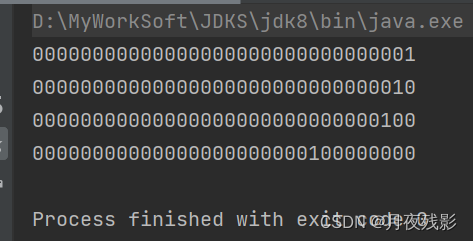
[ test02 ]:
public static void main(String[] args) {int test = 111111;print(test);print(test<<1); //跑过去之后是拿0填充的print(test<<2);print(test<<8);}
//发现———是整体一坨坨移动的。
【输出】:
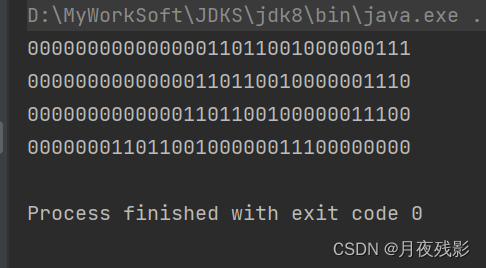
【test03】:
int a = Integer.MAX_VALUE;System.out.println(a);print(a);
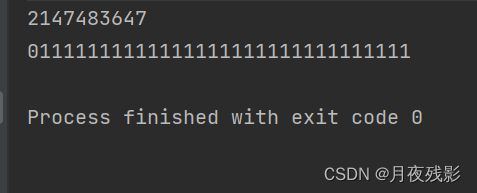
【发现】:
一个32位整型在系统中,不是全部位数都被占用的!!!最左侧的部分是留着的,真正占用的是从右数的0~30共31个位置;
【test04】:
print(-1);int a = Integer.MIN_VALUE;print(a);
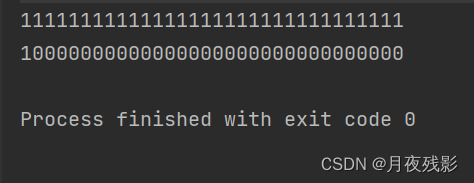
【test05】:取反
int b = 123823138;int c = ~b;print(b);print(c);
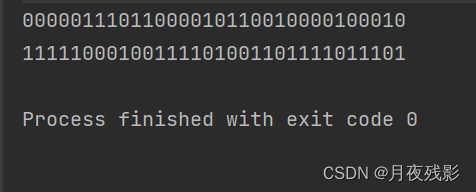
【test06】:右移
int x = 1024;print(x);print(x >> 1);print(x >>> 1);
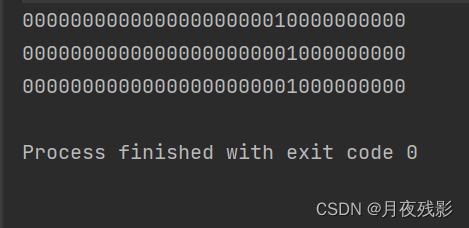
‘’‘’‘’‘’‘’‘’‘’‘’‘’‘’‘’‘’‘’‘’‘’‘’‘’‘’‘’‘’‘’‘’‘’‘’‘’‘’‘’‘’‘’‘’‘’‘’‘’‘’‘’‘’‘’‘’‘’‘’‘’‘’‘’‘’‘’‘’‘’‘’‘’‘’‘’‘’‘’‘’‘’‘’‘’‘’‘’‘’‘’‘’‘’‘’‘’‘’‘’‘’‘’‘’‘’‘’‘’‘’‘’‘’‘’‘’‘’‘’‘’‘’‘’‘’‘’‘’‘’‘’‘’‘’‘’‘’‘’‘’‘’
int a = Integer.MIN_VALUE;print(a);print(a >> 1);print(a >>> 1);
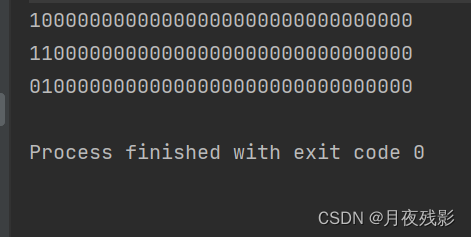
[test07]:
int c = Integer.MIN_VALUE;int d = -c ;System.out.println( c );System.out.println( d );System.out.println("============================");print(c);print(d);

//最小的数取相反数还是它自己。
【J02】:
给定一个参数N , 返回: 1!+2!+3!+4!+ … + N! 的结果。
/*@description:*@author: YguangY*@date: 2023/4/4 21:29/public static long f2(int N) {long ans = 0;long cur = 1;for (int i = 1; i <= N; i++) {cur = cur * i;ans += cur;}return ans;}
【J03】:
排序经典算法——选择排序;
/*@description: 选择排序用到的交换方法;*@author: YguangY*@date: 2023/4/5 15:30/public static void swap(int[] arr, int i, int j) {int tmp = arr[j];arr[j] = arr[i];arr[i] = tmp;}/*@description: 选择排序*@author: YguangY*@date: 2023/4/5 15:30/public static void selectSort(int[] arr) {if (arr == null || arr.length < 2) {return;}int N = arr.length;for (int i = 0; i < N; i++) {int minValueIndex = i;for (int j = i + 1; j < N; j++) {minValueIndex = arr[j] < arr[minValueIndex] ? j : minValueIndex;}swap(arr, i, minValueIndex);}}
【J04】:
经典排序算法——冒泡排序;
/*@description: 冒泡排序。*@author: YguangY*@date: 2023/4/5 15:56/public static void bubbleSort(int[] arr) {if (arr == null || arr.length < 2) {return;}int N = arr.length;for (int end = N - 1; end >= 0; end--) {for (int second = 1; second <= end; second++) {if (arr[second - 1] > arr[second]) {swap(arr, second - 1, second);}}}}/*@description: 排序用到的交换方法;*@author: YguangY*@date: 2023/4/5 15:30/public static void swap(int[] arr, int i, int j) {int tmp = arr[j];arr[j] = arr[i];arr[i] = tmp;}
【J05】:
经典排序算法——插入排序;
/*@description: 插入排序1*@author: YguangY*@date: 2023/4/5 16:49/public static void insertSort1(int[] arr) {if (arr == null || arr.length < 2) {return;}int N = arr.length;for (int end = 1; end < N; end++) {int newNumIndex = end;while (newNumIndex - 1 >= 0 && arr[newNumIndex - 1] > arr[newNumIndex]) { //左边有数(防止指针越界) && 左边的数比我大swap(arr, newNumIndex - 1, newNumIndex);newNumIndex--;}}}/*@description: 插入排序2————优化的算法*@author: YguangY*@date: 2023/4/5 16:49/public static void insertSort2(int[] arr) {if (arr == null || arr.length < 2) {return;}int N = arr.length;for (int end = 1; end < N; end++) {//pre是当前的数的前一个位置;//pre是新数的前一个位置;———新数一开始是在end位置上。for (int pre = end - 1; pre >= 0 && arr[pre] > arr[pre + 1]; pre--) {swap(arr, pre, pre + 1);}}}
【J06】:
函数sum( arr , L , R ) 的作用是求数组[L]位置到[R]位置元素的累加和。

请设计两种数据结构,以便令单次查询更加快捷,同时需要满足如下两种情景:
(1):
低频率的查询场景;
(2):
高频率的查询场景(上亿次)。
public static class RangeSum1 {private int[] arr;public RangeSum1(int[] array) {arr = array;}public int rangeSum(int L, int R) {int sum = 0;for (int i = L; i <= R; i++) {sum += arr[i];}return sum;}}public static class RangeSum2 {private int[] preSum;public RangeSum2(int[] array) {int N = array.length;preSum = new int[N];preSum[0] = array[0];for (int i = 1; i < N; i++) {preSum[i] = preSum[i - 1] + array[i];}}public int rangeSum(int L, int R) {return L == 0 ? preSum[R] : preSum[R] - preSum[L - 1];}}
一种是维护一个矩阵(代码中的RangeSum1 是直接计算L~R,并没有维护矩阵,生成矩阵方法类似,在此不再赘述);
一种是维护一个前缀和数组。
【J07】:研究随机函数
一些对Math.random() 函数的研究;
【test01】:研究概率
public static void main(String[] args) {System.out.println("测试开始");// Math.random() -> double -> [0,1)int testTimes = 10000000;int count = 0;for (int i = 0; i < testTimes; i++) {if (Math.random() < 0.75) {count++;}}System.out.println((double) count / (double) testTimes);System.out.println("=========");}
【输出】:
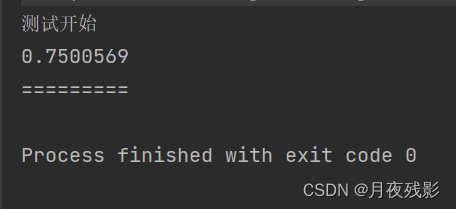
//概率的确非常精准。
【test02】:放缩后当然概率不变了
public static void main(String[] args) {// [0,1) -> [0,8)//扩大之后,也是等概率返回的。int testTimes = 10000000;int count = 0;for (int i = 0; i < testTimes; i++) {if (Math.random() * 8 < 5) {count++;}}System.out.println((double) count / (double) testTimes);System.out.println((double) 5 / (double) 8);}

【test03】:放缩后每一个数的概率测试
public static void main(String[] args) {int testTimes = 10000000;int K = 10;// [0,K) -> [0,K-1]int[] counts = new int[K];for (int i = 0; i < testTimes; i++) {int ans = (int) (Math.random() * K); // [0,K-1]counts[ans]++;}for (int i = 0; i < K; i++) {System.out.println(i + "这个数,出现了 " + counts[i] + " 次");}System.out.println("=========");}
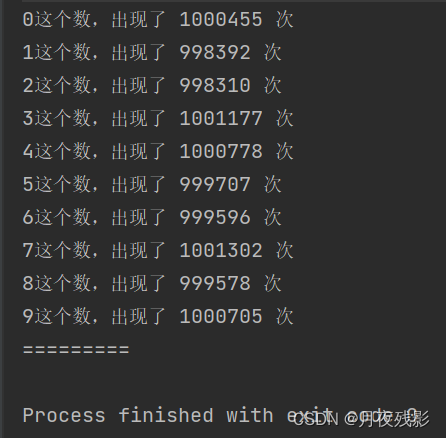
【修改K的值】:
int K = 6;
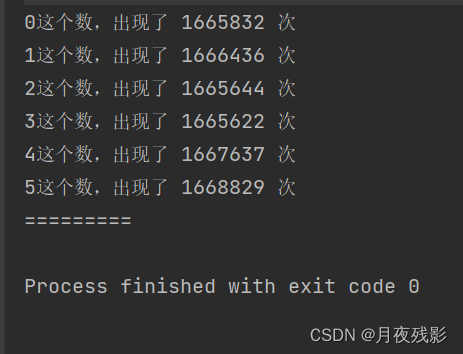
【test04】:调整出现的概率为平方
[0,x]内的数出现的概率为x , 如何将x变为x的平方呢?
public static void main(String[] args) {int testTimes = 10000000;int count = 0;double x = 0.17;for (int i = 0; i < testTimes; i++) {if (xToXPower2() < x) {count++;}}System.out.println((double) count / (double) testTimes);System.out.println(Math.pow(x,2));}// 返回[0,1)的一个小数// 任意的x,x属于[0,1),[0,x)范围上的数出现概率由原来的x调整成x平方public static double xToXPower2() {return Math.max(Math.random(), Math.random());}
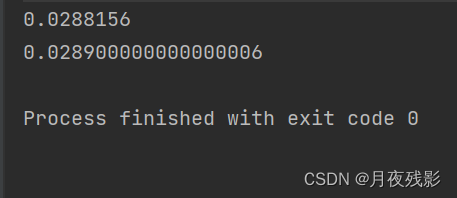
【test05】:调整出现的概率为三次方
[0,x]内的数出现的概率为x , 如何将x变为x的三次方呢?
public static void main(String[] args) {int testTimes = 10000000;int count = 0;double x = 0.3;for (int i = 0; i < testTimes; i++) {if (xToXPower3() < x) {count++;}}System.out.println((double) count / (double) testTimes);System.out.println(Math.pow(x,3));}// 返回[0,1)的一个小数// 任意的x,x属于[0,1),[0,x)范围上的数出现概率由原来的x调整成x平方public static double xToXPower3() {return Math.max(Math.random(), Math.max( Math.random(),Math.random() ) );}
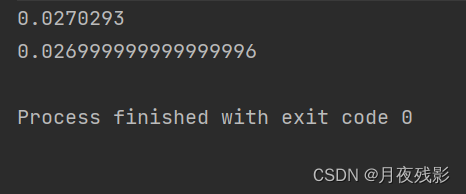
【test06】:使用min的话概率如何计算呢?
min ( 事件A , 事件B )
=》
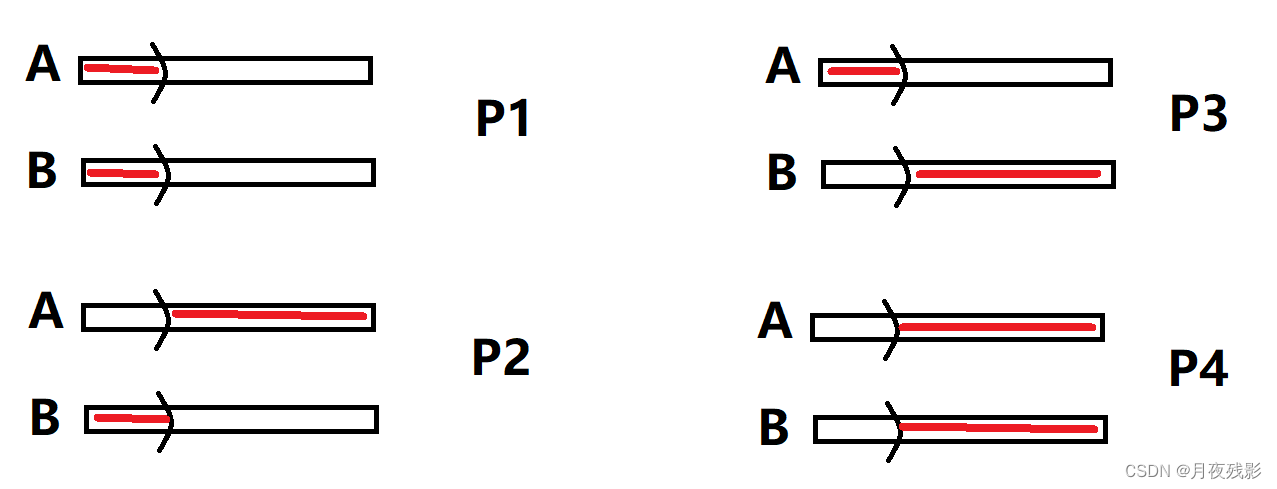
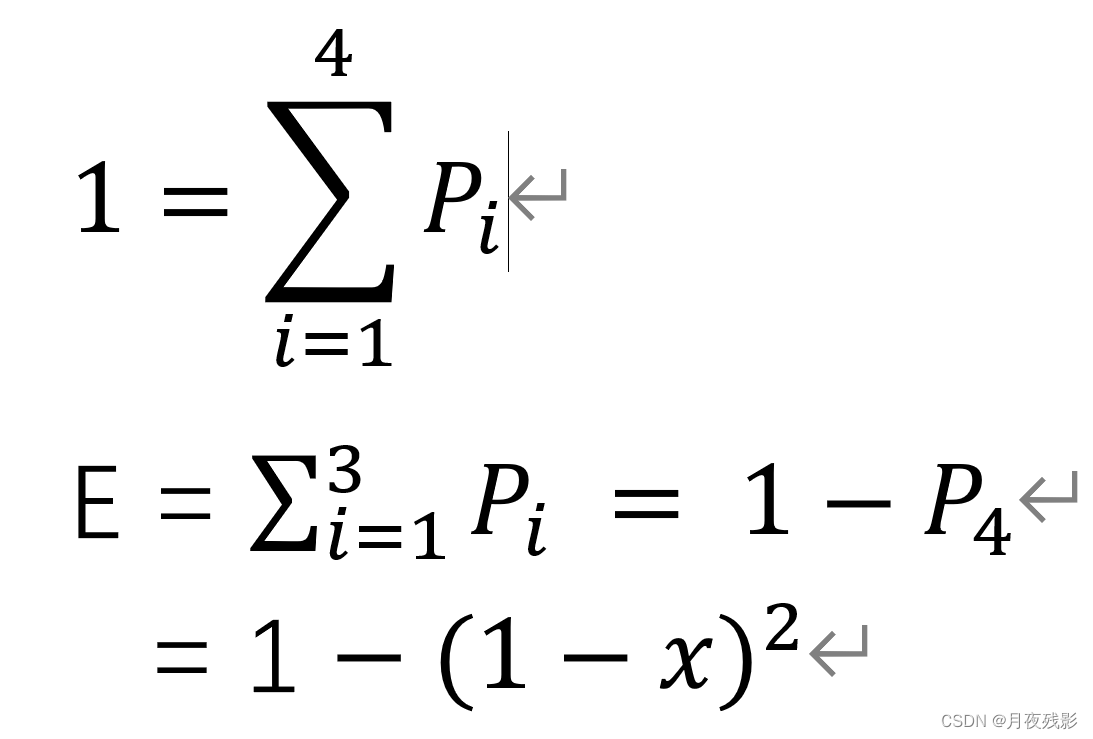
public static void main(String[] args) {int testTimes = 10000000;int count = 0;double x = 0.2;for (int i = 0; i < testTimes; i++) {if (xToXPower3() < x) {count++;}}System.out.println((double) count / (double) testTimes);System.out.println(1-Math.pow(1-x, 2));}// 返回[0,1)的一个小数// 任意的x,x属于[0,1),[0,x)范围上的数出现概率由原来的x调整成x平方public static double xToXPower3() {return Math.min( Math.random() , Math.random() );}
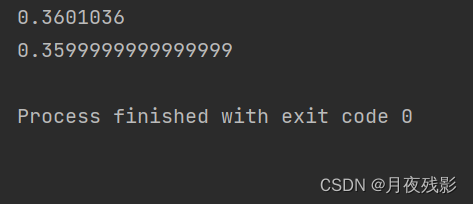
1-(1-0.2)方 ==0.36.
【J08】:
条件函数F()等概率返回 1~5 ;
目标函数G()要求等概率返回 1~7;
【test01】:测试零一发生器的概率
首先改造成零一发生器;
public static void main(String[] args) {int testTimes = 10000000;int count = 0;for (int i = 0; i < testTimes; i++) {if (f2() == 0) {count++;}}System.out.println((double) count / (double) testTimes);}// lib里的,不能改!// 1~5 里等概率返回一个!!!public static int f1() {return (int) (Math.random() * 5) + 1;}// 随机机制,只能用f1,// 等概率返回0和1public static int f2() {int ans = 0;do {ans = f1();} while (ans == 3); //f1得到的不是3 , 才能从循环里出来;return ans < 3 ? 0 : 1;}

//说明零一发生器改造成功了;
【test02】: 0~7等概率返回
// lib里的,不能改!// 1~5 里等概率返回一个!!!public static int f1() {return (int) (Math.random() * 5) + 1;}// 随机机制,只能用f1,// 等概率返回0和1public static int f2() {int ans = 0;do {ans = f1();} while (ans == 3); //f1得到的不是3 , 才能从循环里出来;return ans < 3 ? 0 : 1;}// 得到000 ~ 111 做到等概率 0 ~ 7等概率返回一个public static int f3() {return (f2() << 2) + (f2() << 1) + f2();}public static void main(String[] args) {int testTimes = 10000000;int[] counts = new int[8];for (int i = 0; i < testTimes; i++) {int num = f3();counts[num]++;}for (int i = 0; i < 8; i++) {System.out.println(i + "这个数,出现了 " + counts[i] + " 次");}}
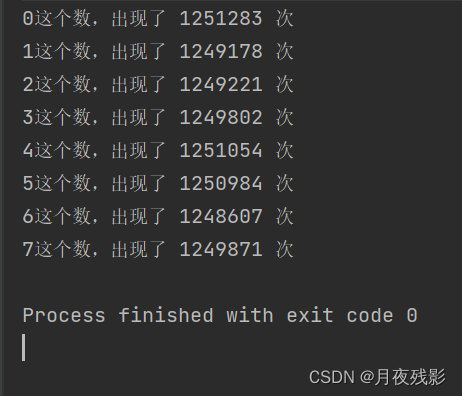
【test03】:1~7等概率返回
// lib里的,不能改!// 1~5 里等概率返回一个!!!public static int f1() {return (int) (Math.random() * 5) + 1;}// 随机机制,只能用f1,// 等概率返回0和1public static int f2() {int ans = 0;do {ans = f1();} while (ans == 3); //f1得到的不是3 , 才能从循环里出来;return ans < 3 ? 0 : 1;}// 得到000 ~ 111 做到等概率 0 ~ 7等概率返回一个public static int f3() {return (f2() << 2) + (f2() << 1) + f2();}// 0 ~ 6等概率返回一个public static int f4() {int ans = 0;do {ans = f3();} while (ans == 0);return ans;}public static int g() {return f4() ;}public static void main(String[] args) {int[] counts = new int[8];int testTimes = 10000000;for (int i = 0; i < testTimes; i++) {int num = g();counts[num]++;}for (int i = 0; i < 8; i++) {System.out.println(i + "这个数,出现了 " + counts[i] + " 次");}}
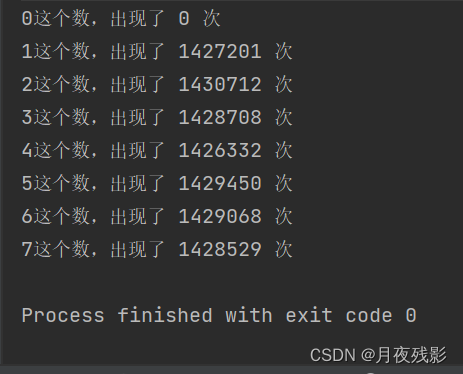
【test04】:
f()函数是3~19上等概率随机的 , 要求目标函数 g() 在20 ~ 56 上等概率随机;
// 3~19 里等概率返回一个!!!public static int f1() {return (int) (Math.random() * 17) + 3;}// 等概率返回0和1public static int f2() {int ans = 0;do {ans = f1();} while (ans == 11); //f1得到的不是11 , 才能从循环里出来;return ans < 11 ? 0 : 1;}// 得到000000 ~ 111111 做到等概率 0 ~ 63等概率返回一个public static int f3() {return (f2()<<5 )+ (f2()<<4) + (f2()<<3) + (f2() << 2) + (f2() << 1) + f2();}// 20 ~ 56等概率返回一个public static int f4() {int ans = 0;do {ans = f3();} while (ans < 20 || ans > 56);return ans;}public static int g() {return f4() ;}public static void main(String[] args) {int[] counts = new int[100];int testTimes = 10000000;for (int i = 0; i < testTimes; i++) {int num = g();counts[num]++;}for (int i = 18; i < 60; i++) {System.out.println(i + "这个数,出现了 " + counts[i] + " 次");}}
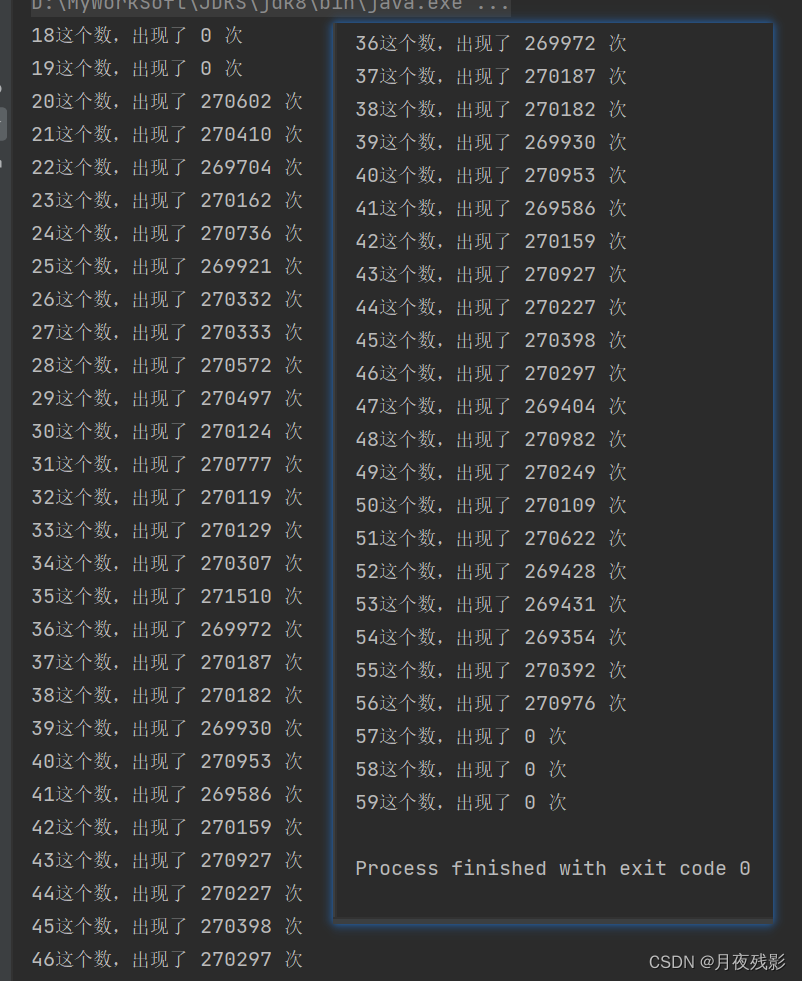
【J09】:
f()函数得到0的概率是P , 得到1的概率是(1-P) , 即只返回0和1 , 但是是不等概率的;
g()函数是目标函数,现在要求目标函数要等概率返回0和1;
// 你只能知道,x会以固定概率返回0和1,但是x的内容,你看不到!public static int x() {return Math.random() < 0.84 ? 0 : 1;}// 等概率返回0和1public static int y() {int ans = 0;do {ans = x();} while (ans == x()); //在这个地方又调用了生成器!!!//即———第一次等于第二次的话,直接重做~ ~ ~ ! ! !return ans;}public static void main(String[] args) {int[] arr = new int[10];for (int i = 0; i < 10000; i++) {int b =y();arr[b]++;}System.out.println(arr[0]);System.out.println(arr[1]);System.out.println(arr[2]);System.out.println(arr[3]);}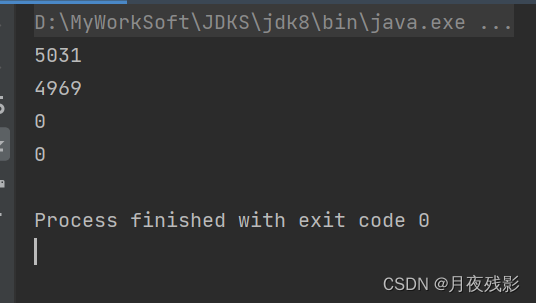
【J10】:
对数器;
//使用对数器验证——选择排序、插入排序是否正确。
public static void selectionSort(int[] arr) {if (arr == null || arr.length < 2) {return;}for (int i = 0; i < arr.length - 1; i++) {int minIndex = i;for (int j = i + 1; j < arr.length; j++) {if (arr[j] < arr[minIndex]) {minIndex = j;}}swap(arr, i, minIndex);}}public static void swap(int[] arr, int i, int j) {int tmp = arr[i];arr[i] = arr[j];arr[j] = tmp;}public static void insertionSort(int[] arr) {if (arr == null || arr.length < 2) {return;}for (int i = 1; i < arr.length; i++) { // 0 ~ i 做到有序for (int j = i - 1; j >= 0 && arr[j] > arr[j + 1]; j--) {swap(arr, j, j + 1);}}}/* @description: 长度随机,内容随机的数组。* @author: YguangY* @date: 2023/4/7 10:23/// 返回一个数组arr,arr长度[0,maxLen-1],arr中的每个值[0,maxValue-1]public static int[] lenRandomValueRandom(int maxLen, int maxValue) {int len = (int) (Math.random() * maxLen);int[] ans = new int[len];for (int i = 0; i < len; i++) {ans[i] = (int) (Math.random() * maxValue);}return ans;}public static int[] copyArray(int[] arr) {int[] ans = new int[arr.length];for (int i = 0; i < arr.length; i++) {ans[i] = arr[i];}return ans;}// arr1和arr2一定等长public static boolean isSorted(int[] arr) {if (arr.length < 2) {return true;}int max = arr[0];for (int i = 1; i < arr.length; i++) {if (max > arr[i]) { //一直递增才是有序的!!!return false;}max = Math.max(max, arr[i]);}return true;}public static void main(String[] args) {int maxLen = 5;int maxValue = 1000;int testTime = 10000;for (int i = 0; i < testTime; i++) {int[] arr1 = lenRandomValueRandom(maxLen, maxValue);int[] tmp = copyArray(arr1);selectionSort(arr1);insertionSort(tmp);if (!isSorted(arr1)) {System.out.println("选择排序错了!");//也可以在此处进行BUG的定位~~~}if (!isSorted(tmp)) {System.out.println("插入排序错了");//也可以在此处进行BUG的定位~~~}}}


